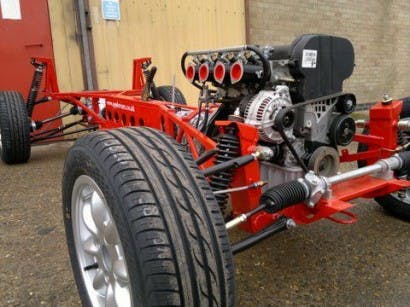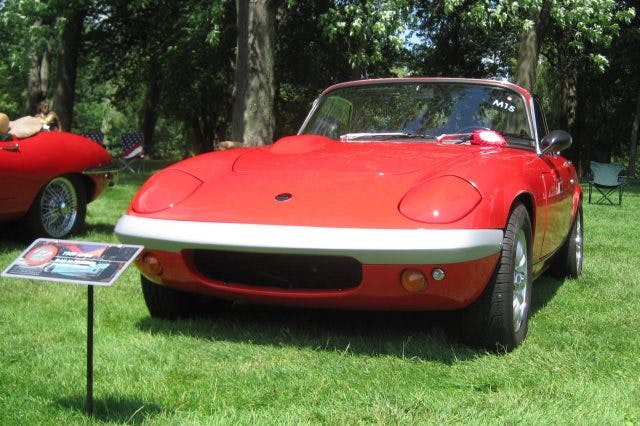Media | Articles
Someone could, and should, make Lotus Elan replicas
Now that the National Highway Traffic Safety Administration has finally gotten around to proposing how it plans on administering the Low Volume Motor Vehicle Manufacturers Act, entrepreneurs hoping to get into the business of making replicas of historic vintage automobiles can actually start planning how to do it. When the legislation was first passed by Congress and signed into law by President Barack Obama in 2015, there were high hopes that we’d see brand new examples of things like the Cord 810 or Checker A8 taxicab, just two of the revival ideas floated back then, but NHTSA took so long to issue the rules that many of those ideas have stalled or died due to uncertainty.
Putting any kind of motor vehicle, replica or original, into even limited production is a huge undertaking. Even though NHTSA is allowing replica makers almost carte blanche when it comes to the chassis and mechanical side of things (providing the individual components used meet the Federal Motor Vehicle Safety Standards for things like tires and brakes), the proposed rules say that the bodies of the replicas must be dimensionally accurate reproductions, even going so far as to require original design drawings and blueprints in the documentation when applying for a exemption under the LVMVMA. You’re not likely going to find Checker bodies sitting on a shelf somewhere, as the parent company sold the tooling as scrap decades ago. Any enterprise that wants to make replicas under the new rules is going to have to have tooling made for the bodies—and if they want the mechanical side of things to be authentic as well, that’s going increase costs considerably.
That’s why the first LVMVMA legal replicas that hit the road may be DeLoreans from Texas-based DeLorean Motor Company. DMC, which bought the rights to the name, as well as almost all of the existing new-old-stock DeLorean parts, plans to sell the replica DMC12s to augment its ongoing business selling DeLorean parts and refurbished and upgraded DeLoreans from its four locations in Texas, Florida, California, and Illinois. DMC doesn’t have to spend a lot of time and money creating reproduction parts, it already has an ample inventory of NOS and repro DeLorean bits.
There is one car, however, that hasn’t been mentioned as a possible LVMVMA replica, and it seems to me that it would be a lot easier than bringing a ’37 Cord or ’60s vintage Checker cab back to life. I’m talking about the 1962–72 Lotus Elan.
Why put the Elan back into production? Gordon Murray, who should know a thing or two about sports cars (having designed the McLaren F1), said that the Elan is the purest, best handling sports car ever made, including his magnum opus, and he owns two Elans. Hagerty contributor Jay Leno, who owns one of those F1s, fell so deeply in love with his Elan that he commissioned a restomodded factory lightweight Elan 26R (the street Elan was Lotus Type 26; the R in 26R stands for racing), so he now also owns two. Speaking of McLaren, Mike Flewitt, the chairman of McLaren Automotive, goes Leno and Murray one better with three vintage Elans, including one he races with his wife. Influential British auto journalist Harry Metcalfe also owns, and loves, an Elan.
Marketplace
Buy and sell classics with confidence
As good as the Mazda Miata, whose styling and joie de driving were inspired by the Elan, may be, some folks just have to have the real deal. Right now, though, the real deal is pretty rare.
There aren’t very many of them; about 14,000 of the two-seat Elan were made in roadster or coupe form. A few thousand more Elan +2 models were sold, but that car, although mechanically very similar to the original, has a completely different body. Having a fiberglass body means that many Elans have survived despite the fact that many of them are more than 50 years old, but Ford makes more F-150 pickup trucks in a week than the total number of Elans made in the span of 10 years. Perhaps a better comparison might be the E Type Jaguar, of which about 75,000 were made, more than five times the number of Elan two-seaters. Supply of Elans is limited.
What about demand? Once seen as a bit old fashioned next to the outer space looking, mid-engine Europa, Elans have been appreciating in value as elite enthusiasts like Murray, Leno, and Flewitt have gotten the word out.
Why do I think it would be relatively easy to make replicas of the Elan? Because right now, for about $5000 plus shipping you can buy a brand new fiberglass Elan body from at least two different vendors in the UK. Tony Thompson Racing make their own and Kelvedon Lotus has them made by a vendor. For many years Miles Wilkins’ Fiberglass Services also made factory licensed bodies and body parts, but he retired three years ago, closed his shop, and reportedly sold off the jigs and fixtures.

Of course, you can’t just slap an Elan body on any chassis. Lotus cars built in the Colin Chapman era typically had one-piece GFRP body shells mounted on a backbone chassis made of welded-up sheet metal. The only frame an Elan will fit on is one made for an Elan. However, our prototypical Elan replica maker is in luck. Not only has the Elan body never gone out of production, you can also buy a brand new factory spec frame for about $2000. Actually, those frames are better than ’60s vintage factory spec since they’re now available with enamel coating to prevent corrosion.

Since the LVMVMA doesn’t require period-correct frames and mechanical, if I were to make Elan replicas, I’d go for an upgrade. Spyder, a UK Lotus specialist, offers a square tube space frame that will bolt right up to the body and accept both original Lotus suspension parts as well as Spyder’s own upgraded components. One nice thing about the Spyder frame is that the company sells an optional roll bar (with safety belt anchors), plus sill and foot box members that, all together, provide significantly more rollover and side impact protection than the stock Elan, which has virtually no crash protection.

The use of a Spyder chassis on a vintage Elan doesn’t seem to detract from its value, but again, a LVMVMA replica maker doesn’t have to spec an authentic chassis.
Replicating the Elan would be made easier by the fact that the original was something of a “bitsa” car. Chapman and his team used off-the-shelf components wherever they could. The Lotus Twin Cam engine is based on the Ford Kent block, and because of the Lotus Cortina, which shared drivetrain components with the Elan, the Elan’s engine, transmission, and rear end parts also have Ford part numbers. In addition to Lotus branded and aftermarket parts there are also NOS OEM Ford parts that will fit. Considering the Elan’s handling prowess, it might surprise you that the front suspension uses some Triumph Spitfire parts, and the steering rack comes from the Triumph parts bin as well, though it has been modified.
I can’t vouch for the story’s veracity, but supposedly in the early-to-mid 1960s, the Lotus factory would sometimes dispatch employees to nearby Ford dealers to pick up parts for production.
It’s true that some Lotus parts like the rear hub carriers and differential housing (the diff itself is a Ford unit), both cast in aluminum, are expensive and hard to find. Along with their space frame, though, Spyder has enough components available that they can sell you a complete rolling chassis with a modern Ford engine that’s not only emissions compliant (as required by the LVMVMA) but also puts out way more power than the original Twin Cam. I know this is heresy to Lotus enthusiasts but you could probably find an automatic transmission that would fit. That would significantly increase any potential market, as about 97 percent of people can’t drive with a stick shift.
Another possible problem with replicating the Elan would be the interior, however a surprising number of NOS and reproduction trim pieces are still available from Lotus specialists in the UK. Besides, it’s a very simple interior. The dashboard is a piece of veneered plywood cut to shape, and the door panels are mostly vinyl covered Masonite. The folks at Kelvedon told me that they’ve been able to do complete restorations on the interiors on a number of Elans and the work is certainly within the wheelhouse of most custom upholstery shops.

With replica bodies easily sourced as well as suitable chassis, mechanical, and interior trim components, what remaining obstacles might there be to putting the Lotus Elan replicas into production? Well, the LVMVMA requires that the replicas be licensed by the owners of relevant intellectual property, so you’d have to make a deal with Lotus. I don’t know if either the current management at Lotus headquarters in Hethel, or their corporate superiors at Geely, which owns the British sports car maker, is amenable to licensing deals, but there are a couple of precedents. The Caterham 7 is a licensed version of the Lotus Seven, Lotus’ original road car, and when the front-wheel-drive M100 Elan went out of production in 1995, Lotus the tooling and rights to Kia, which kept its own Elan in production until 1999.

When Chrysler announced it was ceasing production of the Dodge Viper, I suggested that maybe an affluent Viper enthusiast might be able to keep the Viper assembly line running, similar to what Nate Altman did with the Studebaker Avanti. As it turned out, a group involving James Glickenhaus actually did look into keeping the Viper alive, but the numbers didn’t work out.
Maybe the numbers wouldn’t work out for a revived Elan, but Elan fans include some influential and affluent folks. I wouldn’t be surprised if any of them decided to bring back their favorite car.











